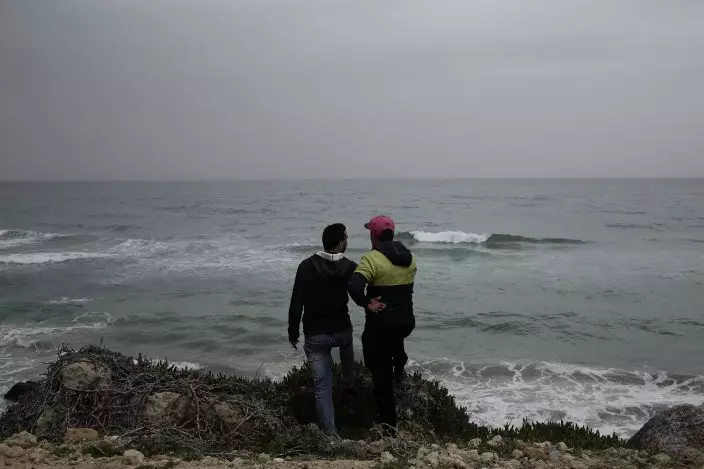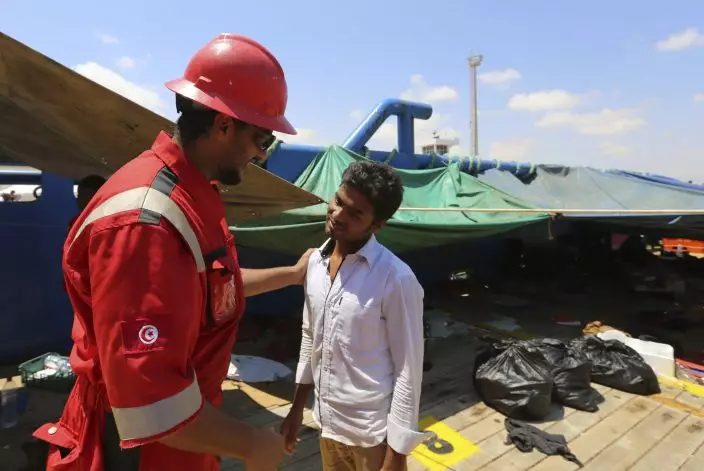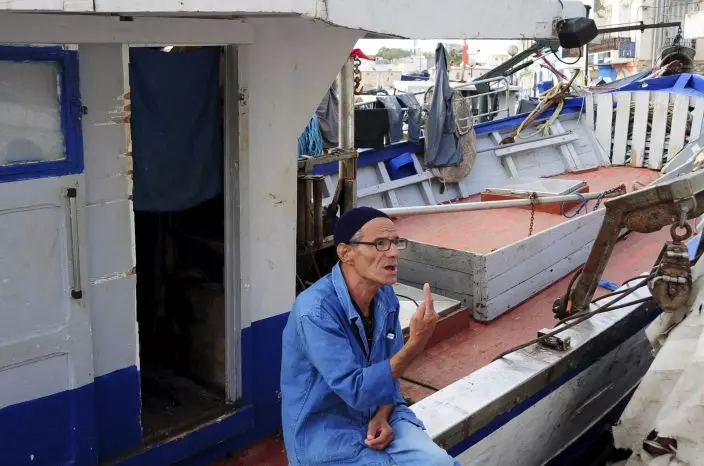Once it was just the jobless young men who set off from Tunisia’s rocky northern beaches for Sicily, usually defying their parents in hopes of a better future.
Now Tunisian families, even those with work or seemingly good prospects, are following that path across 130 kilometers (80 miles) of open water — nearly 10,000 since the beginning of the year and far more than have left in recent memory. The stretch of Mediterranean can be dangerous, the chance of getting asylum in Europe is near zero, and a long quarantine in a ferry anchored offshore will be followed by expulsion if they’re caught.
But many who leave from the Bizerte coastline think the potential reward far outweighs the risk. Those with relatives in Europe are the ones with the new cars and kitchen upgrades.

Imed Helel and his wife Kalthoum Helel talk to The Associated Press in Ras Jebel, near Bizerte, Tunisia, Wednesday, Sept. 23, 2020. The parents fear their son Ghofrane who left Tunisia for Italy last September at the age of 20 was lost at sea. The number of Tunisians migrating clandestinely to Italy has risen to levels not seen since the 2011 Arab Spring uprising. That's causing tensions in Italy's south, where more than 2,200 migrants are quarantining on ferries anchored offshore. (AP PhotoHassene Dridi)
“My son is a month and a half old, and if I get a chance to emigrate immediately, I will go to make a better life,” said Tarek Aloui, a 27-year-old who has tried 10 times to reach Italy since 2014. He has succeeded only once, last March at the height of the coronavirus lockdown, and was expelled almost immediately back home, where he was jailed for six months. He is undeterred.
“All Tunisian men, women and even children want to leave this way,” he added.
Their arrivals have strained the ability of Italy’s southern regions to take them in amid the coronavirus pandemic, given Italy’s quarantine requirements for anyone arriving from outside the EU.

FILE - In this April 14, 2018 file photo, Ahmed Ayouby, 32, left, and Mounir Aguida, 30, who want to leave Tunisia, stand at the beach where migrants leave for Italy, in the town of Ras Jabal, Bizerte, Tunisia. The number of Tunisians migrating clandestinely to Italy has risen to levels not seen since the 2011 Arab Spring uprising. That's causing tensions in Italy's south, where more than 2,200 migrants are quarantining on ferries anchored offshore. (AP PhotoNariman El-Mofty, File)
When a huge fishing boat of 450 Tunisians pulled into port in the Sicilian island of Lampedusa on Aug. 30, some residents took to the docks to protest, shouting at them to go back. Italy’s former interior minister, the anti-migrant League leader Matteo Salvini, criticized the government for letting them in and noted wryly that most will never be granted asylum because they are fleeing the non-existent “famous Tunisian war.”
To keep new migrants safely isolated, the Italian government has commissioned five ferries for newcomers to complete 14 days of quarantine, with 2,238 currently on board the ships. But there are also centers on land for others, and the interior ministry has lamented that Tunisians, more than others, tend to try to flee welcome centers and evade quarantine requirements. Their escapes have sparked protests by local residents fearful of new infections after Italy’s brutal coronavirus outbreak, especially since arriving migrants have been linked to several dozen recent clusters.
Interior Minister Luciana Lamorgese has traveled to Tunis twice since July to negotiate with the new government on the need to stem the flow, including with offers of assistance from Italy to better patrol the coasts. She blamed the increase in Tunisian arrivals on the country’s socio-economic problems that have been exacerbated by COVID-19, and has offered Italian assistance to address them.

FILE - In this Aug. 1, 2018 file photo, a Tunisian Red Crescent volunteer, left, speaks with a migrant aboard the ship "Sarost 5" docked in the southern Tunisian port of Zarzis, Tunisia. The number of Tunisians migrating clandestinely to Italy has risen to levels not seen since the 2011 Arab Spring uprising. That's causing tensions in Italy's south, where more than 2,200 migrants are quarantining on ferries anchored offshore. (AP PhotoMounir Beji, File)
She told a parliamentary committee last week that since Aug. 1, Italy had resumed repatriating Tunisians who don’t qualify for asylum, after reaching an accord with the Tunisian government to accept two flights a week with 40 Tunisians apiece. She said the number of weekly flights would increase starting in October. Tunisian migrants fleeing their country’s worsening economic situation aren’t generally considered eligible for asylum.
While Tunisians have been by far the biggest group of migrants in 2020, the 23,517 migrants in Italy this year are a fraction of the nearly 120,000 people rescued at sea and brought to Italy in 2017, or the more than 181,000 who arrived in the peak year, 2016. This year’s arrivals, however, are more than the numbers seen in the previous two years.
More striking is the proportion of migrants who are Tunisian — 9,284 or 42% this year, compared with 23% last year and 22% in 2018. The year before that, Tunisians only accounted for 5% of arrivals, with Nigerians topping the list.

Fisherman Mohamed Taoueb, 58, talks to The Associated Press on the port of Bizerte, Tunisia, Wednesday, Sept. 23, 2020. The number of Tunisians migrating clandestinely to Italy has risen to levels not seen since the 2011 Arab Spring uprising. That's causing tensions in Italy's south, where more than 2,200 migrants are quarantining on ferries anchored offshore. (AP PhotoHassene Dridi)
Romdhane Ben Amor, spokesman for the Tunisian Economic and Social Rights Forum, said this level of emigration hasn’t been seen since the Arab Spring uprising of 2011 started in Tunisia.
“It’s no longer restricted to those who drop out of school, the unemployed and the uneducated,” he said.
He said between 150 and 200 families have left Tunisia on boats, avoiding the north African country's coast guard despite ramped-up surveillance paid for by Italy and other European Union countries.

A view of the port of Bizerte, Tunisia, where boats similar to the ones used by migrants to reach Italy are docked, Wednesday, Sept. 23, 2020. The number of Tunisians migrating clandestinely to Italy has risen to levels not seen since the 2011 Arab Spring uprising. That's causing tensions in Italy's south, where more than 2,200 migrants are quarantining on ferries anchored offshore. (AP PhotoHassene Dridi)
“We can see them on the surveillance camera in the port,” said Mohammed Taweb, a fisherman in Bizerte. He said small groups come to steal boat engines in preparation for their departures, but only from pleasure craft — not from the fishing boats he and others need to make a living. He said he understands why they go, and believes it’s up to Tunisia’s government to solve the problem.
The parents of Ghofrane Hlel fear it’s too late for their son, who left last September at the age of 20 and was lost at sea. His mother, Kalthoum Fraj, has resigned herself to his fate, but not to the uncertainty.
“I accept everything that happened to him, and I do not hold anyone responsible,” she said. “I want him dead or alive, and I will accept either one.”

Kalthoum Helel holds a picture of her son Ghofrane Helel, in Ras Jebel, near Bizerte, Tunisia, Wednesday Sept.23, 2020. Helel fears her son Ghofrane who left Tunisia for Italy last September at the age of 20 was lost at sea. The number of Tunisians migrating clandestinely to Italy has risen to levels not seen since the 2011 Arab Spring uprising. That's causing tensions in Italy's south, where more than 2,200 migrants are quarantining on ferries anchored offshore. (AP PhotoHassene Dridi)
Nicole Winfield in Rome and Lori Hinnant in Paris contributed to this report.

FILE - In this Monday, June 4, 2018 file photo, Tunisian men react as they wait for news of friends and relatives after the sinking of a boat carrying migrants the previous day, in the coastal city of Sfax, Tunisia. The number of Tunisians migrating clandestinely to Italy has risen to levels not seen since the 2011 Arab Spring uprising. That's causing tensions in Italy's south, where more than 2,200 migrants are quarantining on ferries anchored offshore. (AP PhotoFile)

Tarek Aloui talks to The Associated Press on the beach of Ras Jebel, near Bizerte, Tunisia, Wednesday Sept. 23, 2020. Aloui has tried 10 times to reach Italy since 2014. He has succeeded only once, last March at the height of the coronavirus lockdown, and was expelled almost immediately back home, where he was jailed for six months. The number of Tunisians migrating clandestinely to Italy has risen to levels not seen since the 2011 Arab Spring uprising. In Tunisia, the departures now include families and even people who have jobs but can no longer count on their income being enough. (AP PhotoHassene Dridi)


